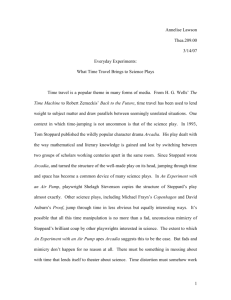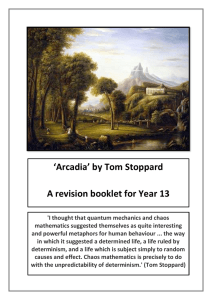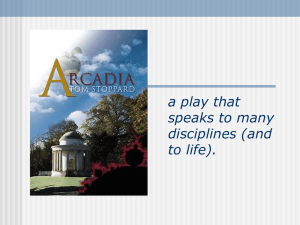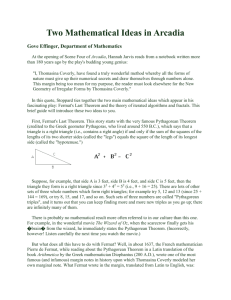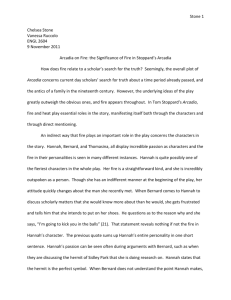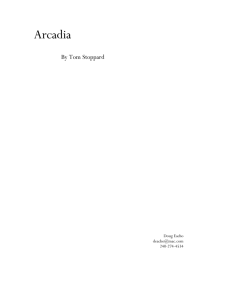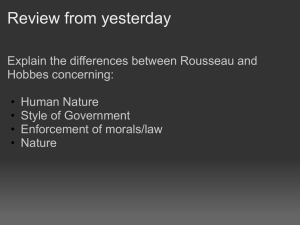arcadia12 - The Universe is made of stories, not of atoms.
advertisement
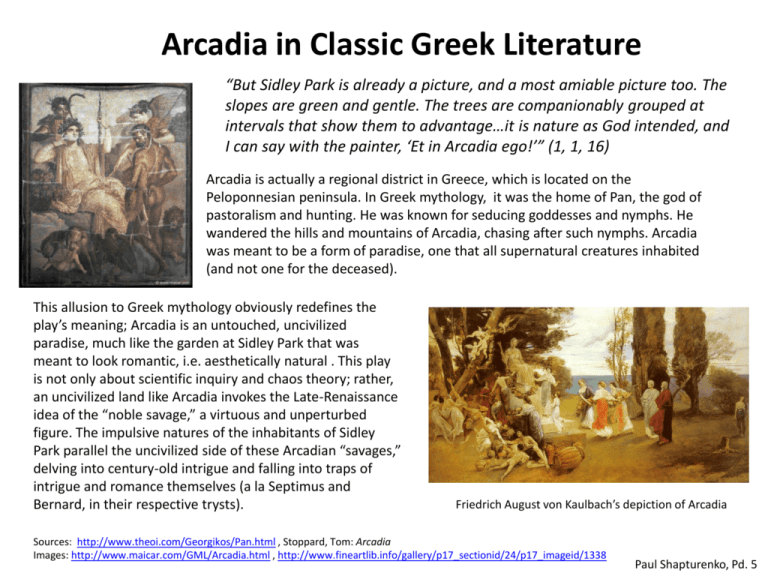
Arcadia in Classic Greek Literature “But Sidley Park is already a picture, and a most amiable picture too. The slopes are green and gentle. The trees are companionably grouped at intervals that show them to advantage…it is nature as God intended, and I can say with the painter, ‘Et in Arcadia ego!’” (1, 1, 16) Arcadia is actually a regional district in Greece, which is located on the Peloponnesian peninsula. In Greek mythology, it was the home of Pan, the god of pastoralism and hunting. He was known for seducing goddesses and nymphs. He wandered the hills and mountains of Arcadia, chasing after such nymphs. Arcadia was meant to be a form of paradise, one that all supernatural creatures inhabited (and not one for the deceased). This allusion to Greek mythology obviously redefines the play’s meaning; Arcadia is an untouched, uncivilized paradise, much like the garden at Sidley Park that was meant to look romantic, i.e. aesthetically natural . This play is not only about scientific inquiry and chaos theory; rather, an uncivilized land like Arcadia invokes the Late-Renaissance idea of the “noble savage,” a virtuous and unperturbed figure. The impulsive natures of the inhabitants of Sidley Park parallel the uncivilized side of these Arcadian “savages,” delving into century-old intrigue and falling into traps of intrigue and romance themselves (a la Septimus and Bernard, in their respective trysts). Friedrich August von Kaulbach’s depiction of Arcadia Sources: http://www.theoi.com/Georgikos/Pan.html , Stoppard, Tom: Arcadia Images: http://www.maicar.com/GML/Arcadia.html , http://www.fineartlib.info/gallery/p17_sectionid/24/p17_imageid/1338 Paul Shapturenko, Pd. 5 Samuel Taylor Coleridge 1772-1834 An important English Romantic poet, often grouped together with Lord Byron and William Woodsworth for their level of importance in the movement. Presentation by Serhiy Hvirtsman “No, no . . . However, Coleridge died in 1834.” – Bernard, p. 29. - This is a response to Hannah’s statement that the hermit she is studying died in 1834. - He is only mentioned once throughout the entire book. Purpose of his inclusion: • As a way to prepare both Hannah and the reader for the reveal that Bernard is at Sidney Park to study the connection with Lord Byron. • As a way to demonstrate to Hannah that Bernard is knowledgeable in the field of literature, allowing her to speak more freely. (Her tone is described as “softening”). • To make a connection between Septimus, the hermit who Hannah is studying, and Coleridge. Coleridge is a hermit? The following regards the last point on the previous slide. Coleridge became an opium addict late in his life, and moved in with Dr. James Gillman in Highgate hoping to cure his addiction. Colerdige continues publishing some works, but he almost never leaves the house, like a hermit. Perhaps Tom Stoppard is comparing this to the behavior of the hermit who lives at Sidney Park, Septimus Hodge. Chaos Theory in Biology (Population) Kevin Peng xn+1=rxn(1-xn) Fixed – population approaches a stable value Stable – population bounces between two or more different values Chaotic – no pattern; the population will eventually visit every point on the interval (0,1); Small changes in initial condition will have large effects in the future a. Fixed b. Periodic c. Periodic d. Chaotic Valentine's Research •“This year there are x goldfish. ... Nature manipulates the x and turns it into y. Then y goldfish is your starting population for the following year. Just like Thomasina. Your value for y becomes your next value for x” (45). •“Each drip sets up the conditions for the next, the smallest variation blows prediction apart... The future is disorder”(48). Z. Kaczmarek Arcadia and The Butterfly Effect The butterfly effect is a phenomenon in which a small change in initial conditions makes a significant difference in the outcome of a situation. It is called the butterfly effect because Edward Lorenz, who came up with the idea, used the image of flapping butterfly wings as having a noticeable effect on the weather to summarize his ideas.1 The butterfly effect is part of chaos theory, in which outcomes determined by their initial conditions are nevertheless not predictable because they vary greatly from tiny changes in initial conditions.2 start •We see an example of this in Arcadia, where Thomasina's death is accident, caused simply by the placement of her candle next to her essay. Or so we assume, as the fire is not explicitly described. The only references to it are Septimus' warning, “Be careful with the flame,” and the stage directions, “She puts the candlestick and the essay on the table” (100-101). As with all cases, the butterfly effect can only be examined theoretically. We hypothesize that some small unpredictable event—a small breeze combined with the risky placement of the candle—caused the fire. Perhaps if had she been more careful, or had Septimus come up to her room with her, she would not have died. And, if she hadn't died, would she have made any important discoveries? Thomasina's death alone is a huge consequence for something as tiny as a breeze, but one also has to consider the rest of her life. Maybe she would have continued her work and found something great. Or maybe she would have stopped, Septimus would not have done all his work in the hermitage, and Hannah would not have even been looking into him later. 1http://en.wikipedia.org/wiki/Chaos_theor y 2Images from http://upload.wikimedia.org/wikipedia/commons/thumb/8/8e/Chaos_Sensitive_Dependence.svg/500pxhttp://en.wikipedia.org/wiki/Butterfly_eff Chaos_Sensitive_Dependence.svg.png ect E60X Pd 5 Mini Research Project 2.6.12 and http://kateevangelistamovies.blogspot.com/2010/03/butterflies-and-fluttering-wings.html Waltzing in Arcadia •The waltz was considered a scandalous dance. Dance partners held each other very tightly. The dance can be thought of as carnal embrace. •Thomasina predicts eminent disaster because she knows that infatuation only leads to disaster, using Cleopatra as a prime example. •“Everything is turned to love…and away goes the empire like christening mug into a pawn shop” (42) •The steps of the waltz can change according to which beat of the three the music puts emphasis on. The style is consistent, the steps vary. •The play is supposed to end when Thomasina dies. It was the last event we know happened in the past. But it actually ends on this dance, which introduces entropy. The middle may as well be the end, and vice versa. The order of events is as arbitrary as the steps of the waltz. •Valentine proposes that “the future is disorder” (52). The world is going to end up in entropic disarray, but Stoppard suggests that one should just savor the moment. We as readers know that disaster occurs after the dance, but the characters enjoy themselves in the moment. The 2nd Law of Thermodynamics Energy spontaneously tends to flow only from being concentrated in one place to becoming diffused or dispersed and spread out. "But the heat equation cares very much, it only goes one way. That is the reason Mr. Noakes's engine cannot give the power to drive Mr. Noakes's engine." (91) rice pudding cannot be stirred backwards Septimus and Thomasina's relationship starts with concentrated passion and disperses with her death and his hermitage. Garden of Eden In the story of Adam and Eve, the Garden of Eden is a utopia in which there is no sin or corruption. The prominence of the garden in the setting of Arcadia is an allusion to the Garden of Eden – a simple world that can be defined by a formula. The apple in this biblical story represents sin, often in the form of passion and sexuality. In Arcadia, there is an apple used by several characters in different scenes and time periods that is also an allusion to this idea. Thomasina recognizes sex as a sin in her criticism of Cleopatra, for whom “everything is turned to love” (Stoppard 42). However, when Thomasina succumbs to her love for Septimus, she tastes the forbidden fruit and ends up dying in a fire that destroys much of her work and acquired knowledge as well. Love and sex destroy the possibility of a mathematically structured universe by adding in unplanned “heat”, in the same way that Eve taking a bite out of the apple supposedly filled our world with evil. Free Will • The ability to make choices free from certain kinds of constraints. • The constraint is usually determinism. • There are two prominent opposing positions that address the philosophical positions related to the problems of free will and determinism : – the claim that determinism is false and free will exists – the claim that determinism is true and free will does not exist. Apples and Free Will • Newton’s Law of Motion was inspired by a falling apple. – Suggests that everything is predetermined – However, because one can use Newton’s equations of motion to obtain accurate results or determine the events one wants to happen, the laws can be taken as a form of free will. • “If you could stop every atom in its position and direction, and if your mind could comprehend all the actions thus suspended, then if you were really, really good at algebra you could write the formula for all the future” (9-10). – Thomasina • Because one can use Newton’s equations of motion to obtain accurate results and determine the events one wants to happen, they can be taken as an illusion of free will. Apples and Free Will • “Time must needs run backward, since it will not, we must stir our way onward mixing as we go, disorder out of disorder into disorder until pink is complete, unchanging and unchangeable, and we are done with it forever. This is known as free-will or self determination” (12). – Septimus • Septimus believes that free will and fate are not mutually exclusive and that, even though the end result may be determined already, the way to get to the end result is up to us. • This is reinforced in scene four, when Valentine conducts his experiment on goldfish. • As Valentine uses iteration to study how the population of goldfish changes, he notices a paradox. Although the population of his goldfish is highly sensitive to local conditions, it seems to follow a universal pattern. His results seem to support the fact that free will and determinism may both exist. Chaos Theory and Arcadia A chaotic model is a system which is deterministic, non linear and most importantly displays sensitive dependence, the concept that a minute change in conditions can propagate through the system over a period of time and come to have major effects1. It is this principle that is most notable and which gives the theory its name. This notion that a single change in a system can cause chaos is also quite prominent in Arcadia. The first suggestion of chaos theory is from Thomasina, who suggests that the world is deterministic: “If you could stop every atom in its position and direction, and if your mind could comprehend all the actions thus suspended, then if you were really, really good at algebra, you could write the formula for all the future; and although nobody can be so clever as to do it, the formula must exist just as if one could.” (Stoppard, 9-10)2 This hypothesis is quite impressive coming from the teenage Thomasina, and shockingly similar to an omniscient being theorized by Pierre Simon Laplace eleven years later that would come to be known as “Laplace’s demon”3: Cluttered table6 Pierre Simon Laplace 5 “An intellect which at a certain moment would know all forces that set nature in motion, and the position of all items of which nature is composed, if this intellect were also vast enough to submit these data to analysis, it would embrace in a single formula the movements of the greatest bodies of the universe and those of the tiniest atom; for such an intellect nothing would be uncertain and the future just like the past would be present before its eyes” (Pierre Simon Laplace, A Philosophical Essay on Probabilities)4 Another important occurrence of chaos in Arcadia comes from the relationship between the modern and nineteenth century settings. The characters in the modern era are trying to uncover the mystery of what happened in the past, in part by finding artifacts and documents left by the actors of the earlier period. Gradually, random items coalesce and appear to the modern characters as distributed without sense or order, but through investigation and with the help of a chaotic table, the underlying order which lies behind the apparent chaos is revealed. Citations 1,3 Smith, Leonard A. Chaos: A Very Short Introduction. Oxford: Oxford UP, USA, 2007. Print. Stoppard, Tom. Arcadia. London: Faber and Faber, 1993. Print. 4 Laplace, Pierre S. "A Philosophical Essay on Probabilities." The Information Philosopher. Web. 06 Feb. 2012. <http://www.informationphilosopher.com/freedom/laplaces_demon.html>. 5 Madame Feytaud. Pierre-Simon Laplace. 1842. Wikipedia, the Free Encyclopedia. Web. 06 Feb. 2012. <http://en.wikipedia.org/wiki/Pierre-Simon_Laplace>. 6 Google Images. Photograph. Google. Web. 06 Feb. 2012. <http://www.google.com/imgres?hl=en>. 2 Lord Byron: The Phantom of Arcadia AP Metaphysics Pd. 5 Xinni Liu Where Art Thou, Lord Byron? Although Byron is never physically present in any of the scenes in Tom Stoppard’s Arcadia, he plays a Romantic role in both time periods of the play. Simply put, Byron embodies the same characteristics of the Byronic hero, which he created. The Ghost of Byron: The Past and The Present • The rampant gossip of Byron’s misdeeds has Byron labeled as a mysterious, arrogant, and womanizing intellectual. Thomasina says, “Mama is in love with Lord Byron…[he] was reading to her from his satire, and Mama was laughing, with her head in her best position…He paid you a tribute, Septimus…it concerned a book called ‘The Maid of Turkey’ and how you would not give it to your dog for dinner” (Stoppard 40). • Despite the fact that the chronology of events in Byron’s life seemed unclear, Bernard recreates the story of Byron’s life by once again, imposing traits of the Byronic hero on the poet. Trying to make sense of Byron’s presence in a game book on Lady Croom’s estate, Bernard declares that “the first thing [Byron] des is seduce Chater’s wife. All is discovered. There is a duel…[The story] dropped from sight but we will write it again” (Stoppard 54). Batman, The Phantom of Gotham City? • Since the 18th century, the concept of the Byronic hero has transpired through many different mediums of entertainment; one example being comics. The characterization of Bruce Wayne in the the comic series Batman, by Bob Kane and Bill Finger, is similar to Byron’s character in Arcadia. Newton’s Apple • Background – One day, Issac Newton was sitting under an apple tree and an apple fell onto his head. He figured that the Earth attracts the apple, and the apple attracts the Earth, in proportion to its quantity (mass). – From this, the universal law of gravitation came into being. 𝑚1 𝑚2 𝐹𝑔 = 𝐺 𝑑2 Newton’s Apple in Arcadia • “The future is all programmed like a computer.” (77) Chloe • “The only thing going wrong is people fancying people who aren’t supposed to be in that part of the plan.” (78) –Chloe • “Ah. The attraction that Newton left out. All the way back to the apple in the garden.” (78) -Valentine • Main forces that make a system unstable – Gravity – Unplanned sexual attractions • The formula for the world is predetermined (determinism) – Except these two forces can make it turbulent. – Relates to chaos theory; a mysterious force. “the attra ction that newt on left out.” • Chloe: The universe is deterministic all right, just like Newton said, I mean it's trying to be, but the only thing going wrong is people fancying people who aren't supposed to be in that part of the plan. • The theme of human attraction manifests itself in two ways: As sa id in th What it means: e • Valentine: Ah. The attraction pl that Newton left out. All the way back to the apple in the garden. ay (78) : – Romance: As represented by Cleopatra, and – Sex: As represented by Septimus and his wild sexcapades. • Chloe posits that human interaction defies determinism. • Sex juxtaposed with academia, striking a contrast. – Hannah: Oh, your lecture. – Bernard: No. no, bugger that. Sex. (67) • Found in the Book of Genesis • God creates Adam and Eve, and puts them into a paradise garden • They have no knowledge, and are forbidden by God to eat from the Tree of Knowledge of Good and Evil • A talking serpent, representing the Devil, tempts Eve to eat the fruit, and Adam follows her • The two gain the understanding of their nakedness, and cover themselves before God discovers their disobedience • The consequences are that Adam and Eve are banished from Eden, the snake must crawl on its belly, women must suffer the pain of childbirth, and man must work the ground. Sidley Park • Its initial Romantic look is described by Lady Croom as “nature as God intended” (16). • Noakes, who introduced many more irregularities into the garden is “in the scheme of the garden, … the serpent” (8) The Apple; The Forbidden Fruit • Chloe’s theory that sexual attraction disproves a deterministic universe: “Ah. The attraction that Newton left out. All the way back to the apple in the garden” (78). • Gus gives Hannah’s an apple as a sign of attraction. • Thomasina’s idea of iteration is inspired by the leaf of an apple. The Consequences of Knowledge and Attraction • Thomasina discovers that thermodynamics suggest that the “Universe must cease and grow cold” (98). Septimus’s (the hermit’s) hut is filled with “cabalistic proofs that the world is coming to an end” (31). • Septimus’s “carnal embrace” with Lady Chater nearly results in a duel • Thomasina’s attraction for Septimus ends with her death. The Steam Pump Kori Porosnicu-Rodriguez “The Emperor of Irregularity!” -Thomasina, pg.89 “…the slopes are green and gentle…” -Lady Croom, pg.16 William Matthews, Arcadia (pre-1809 garden) “…an eruption of gloomy forest and towering crag…” -Lady Croom, pg.16 William Matthews, Arcadia (post-1812) "You do not suppose, my lady, that if all of Archimedes had been hiding in the great library of Alexandria, we would be at a loss for a corkscrew? I have no doubt that the improved steam-driven heat-engine which puts Mr. Noakes into an ecstasy that he and it and the modern age should all coincide, was described on papyrus.“ -Septimus, pg.42 Pg. 85: Septimus: A prize essay of the Scientific Academy in Paris. The author deserves your indulgence, my lady, for you are his prophet. Thomasina: I? What does he write about? The waltz? Septimus: Yes. He demonstrates the equation of the propagation of heat in a solid body. But in doing so he has discovered heresy- a natural contradiction of Sir Isaac Newton. Thomasina: Oh!- he contradicts determinism? Septimus: No!...Well, perhaps. He shows that the atoms do not go Joseph Fourier: On the Propagation of Heat in Solid Bodies according to Newton. “Septimus: Why does it mean Mr. Noakes’s engine pays eleven pence in the shilling? Thomasina: Nowhere. I noticed it by the way. I cannot remember now. Septimus: Nor is he interested by determinismThomasina: Oh…yes. Newton’s equations go forwards and backwards, they do not care which way. But the heat equation cares very much, it goes only one way. That is the reason Mr. Noakes’s engine cannot give the power to drive Mr. Noakes’s engine. Septimus: Everybody knows that. Thomasina: Yes, Septimus, they know it about engines!” -Pg. 91 Works Cited 1. http://www.cherwell.oxon.sch.uk/arcadia/outline0.htm 2. http://www.tim-thompson.com/entropy2.html 3. http://www.robertnowlan.com/pdfs/Fourier,%20Joseph.pdf 4. http://www.todayinsci.com/F/Fourier_JBJ/FourierPoliticianScienti stBio.htm 5. http://farm8.staticflickr.com/7155/6707002471_aa9f0c61cd_o.jpg 6. http://www.arionpress.com/images/matthews/gallery62.html Brideshead Revisited -- G. Chau • Novel by English writer Evelyn Waugh (1945) • “Yes, I met him. Brideshead Regurgitated.” -Bernard (27) • Brideshead was the name of the estate (like Sidley Park), also the name that referred to a son living there, who was often seen as distant and cold • Both works shared a common theme: Et in Arcadia Ego Et in Arcadia Ego (The Shepherds, 1637) Examples in the Text • “…I can say with the painter, ‘Et in Arcadia Ego!’ ‘Here I am in Arcadia,’ Thomasina.” – Lady Croom (16) • “A calendar of slaughter. ‘Even in Arcadia, there am I!’” – Septimus (17) • “Oh, phooey to Death!” – Thomasina (17) Et in Arcadia Ego • Painting referred to the fact that Death was always present – even in the utopia Arcadia was supposed to be • Represented the idea that nothing would last forever – not the happiness that Septimus and Thomasina enjoyed nor the universe • Death clearly plays prominent role, as Thomasina dies after the play ends (even though we never see any of the deaths that happen) • Also plays with the clash between Classical (Arcadia) and Romanticism (Noake’s new garden) FERMAT’S LAST THEOREM Fermat’s last theorem "To write the cube of a number as a sum of two cubes, or the fourth power as a sum of two fourth powers, or any power above 2 as a sum of two like powers, is impossible. I have a truly wonderful proof of this fact, but the margin is too narrow to contain it." n A + n B ≠ n C "I, Thomasina Coverly, have found a truly wonderful method whereby all the forms of nature must give up their numerical secrets and draw themselves through numbers alone. This margin being too mean for my purpose, the reader must look elsewhere for the New Geometry of Irregular Forms by Thomasina Coverly." FRACTALS James Chu Fractals • • • • • Fractals are basically figures that have complex and irregular formations at all scales of measurement. The term was coined by Benoit Mandelbrot when he observed coastlines. Fractals were developed to study nature. Self Similarity: Fractals exhibit the property of Self-Similarity, in which parts of the object bears resemblance to the entire object (Perfect, Approximate, Brownian) Iteration: Fractals are produced through repeating certain steps, which creates a pattern. This process is called iteration. In order to create a true fractal, you would have to iterate an infinite amount of times. Iteration may seem chaotic and disorderly at times, but the resulting fractal is orderly. The Sierpinski Triangle Mandelbrot Set Naturally Occurring Fractal Fractals In Arcadia • • • • • Both Thomasina and Valentine utilize fractals and iteration for their respective studies: Thomasina: What a faint-heart! We must work outward from the middle of the maze. We will start with something simple. (She picks up the apple leaf.) I will plot this leaf and deduce its equation. (Pg 41) Valentine: The Coverly Set. Hannah: The Coverly Set! My goodness, Valentine! Valentine: …In an ocean of ashes, islands of order. Patterns making themselves out of nothing. I can’t show you how deep it goes. Each picture is a detail of the previous one, blown up. And so on. For ever. (Pg 80) The multiple parallels between the two different eras demonstrate the property of selfsimilarity (certain aspects of the plot and characters). Furthermore, in Scene 7, the presentera and past-era characters are wearing Regency clothing. Stoppard attempts to portray a key concept of fractal: within the chaos that is iteration, there is an underlying order (evident in The Chaos Game) Here, self-similarity between periods contrasts the chaos of time. The entire structure of Arcadia is that of a fractal. Each scene undergoes iteration, in which the plot of the previous scene feeds into that of the next scene, producing unpredictable results (i.e. Thomasina’s death, Chloe + Bernard). This culminates in the final scene, where the two eras blend. Despite this disorder, the structure of the play remains orderly. There three scenes in the past, three in the present, and the seventh scene which has six subscenes: two in the past, two of the present, and two where the characters of both eras appear. Fractals in Arcadia Contd. • • • If you were to plot Scene Seven’s changes in periods, the result would be the following: This may exhibit certain aspects of fractality. Furthermore, fractals can also represent the shift from Romanticism into Classicism, as nature becomes entwined with Euclidean geometry. Works Cited Aronov, Dmitriy, Mikhail Radomyselskiy, and Ming J. Po. "Fractals Unleashed." Library.thinkquest.org. Web. 6 Feb. 2012. <http://library.thinkquest.org/26242/full/>. "Tom Stoppard's Arcadia - John Patrick Fleming." Google Books. Web. 06 Feb. 2012. <http://books.google.com/books?id=IsOlMchQzRUC>. "Tom Stoppard's Arcadia." Classes.yale.edu. Web. 6 Feb. 2012. <http://classes.yale.edu/fractals/panorama/Literature/Stoppard/Stoppard.html>. GOTHIC GARDEN STYLE AND CAPABILITY BROWN Gothic Garden Style • Garden - one of bridges between past and present • Background for characters’ motives • Noakes’ design – elements of Gothic literature and art: – Gothic – part of Romantic period – Horror, dread, deterioration – “gloomy forest… towering crag… ruins… water dashing against rocks… haunt for hobgoblins… fallen obelisk overgrown with briars” (16) • Noakes – changes in tastes Capability Brown • • • • Various references (29-30, 31, 53, 87) Head Gardener at Stowe Lady Croom – traditional – Refers to Noakes as “‘Culpability’ Brown” (87) – pun on Lancelot Capability Brown’s name – Hannah: “English landscape was invented by gardeners imitating foreign painters who evoked classical authors. The whole thing was brought home in the luggage from the grand tour. Here, look— Capability Brown doing Claude, who was doing Virgil. Arcadia! And here, superimposed by Richard Noakes, untamed nature in the style of Salvator Rosa. It’s the Gothic novel expressed in landscape. Everything but vampires” (30) William Wordsworth (1770-1850) Background: • English Romantic poet • joint publication Lyrical Ballades with Coleridge initiated the Romantic Age • “Wordsworth has an insight into permanent sources of joy and consolation for mankind which Byron has not; his poetry gives us more which we may rest upon than Byron's” (Arnold) “They read a damn sight more like Byron than Byron’s review of Wordsworth the previous year” Bernard asserts (Stoppard his point that 34).the copy of “The Couch of Eros” belonged to Byron, since“all underlined passages, word for word, were used as quotations in the review of [it]” (34). Bernard mentions Wordsworth to stress that Byron review of “The Couch of Eros” was a should be ridicule, just as how Byron“You mocked Wordsworth in Piccadilly. If Byron proud to be in was not on friendly terms with Chater, the author of “The Couch of theon company Eros,” just as how he was not friendlyofterms with Wordsworth, Stewart McGowan as Ezra Chater. Rufus Sewell as Septimus Hodge. Rogers and Bernard uses this as evidence that Byron had killed Chater. Lady Croom states this to Chater to suggest that it is an honor Moore and to be insulted by Byron in his English Bards and Scotch Reviewers, just The allusions ofWordsworth— Wordsworth always used Chater in the context as how Rogers, Moore, and Wordsworthwere were. However, retorts ah!” (44). of Chater’s Throughout the play, Bernard asserts that Lord that “[it] is apoetry. doggerel aimed at Lord Byron’s seniors and betters” (44). Byron had killedLady’s Chater becauseadmiration of the similar treatment This also shows Croom’s towards Byron.he had given towards Wordsworth. This misconception ultimately brings mystery to References the play, where the negative acts Septimus had committed were thought to be doneByron’s by LordPoems. Byron,New simultaneously giving Septimus Arnold, Matthew. York, Thomas Y. Crowell & Co., 1884. characteristics of a Byronic Hero. This is critical to the plot, as it Print. Gardens of the Enlightenment Longleat Estate before it was redesigned by "Capability Brown" Longleat Estate after it was redesigned by "Capbility Brown" "Capability Brown" in Arcadia Lancelot Brown, known as "Capability Brown" designed English gardens and landscapes. As described by Hannah, "English landscape was invented by gardeners imitating foreign painters who were evoking classical authors. The whole thing was brought home in the luggage from the grand tour. Here, look Capability Brown doing Claude, who was doing Virgil. Arcadia!" (29). Sidley Park was redesigned during the Enlightenment: "smooth, undulating, serpentine - open water, clumps of trees, classical boathouse" (29). Designs of Gardens of the Enlightenment During the Enlightenment, gardens were neatly trimmed, with "only useful or decorative plants allowed to grow, and every weed meticulously uprooted. The trees would be planted according to mathematical models for harmonious spacing, and the shrubbery would be pruned into geometric shapes such as spheres, cones, or pyramids." Nature was "something to be shaped according to the dictates of human will and tamed according to the rules of human logic." Designs of Gardens of the Romantic Era The orderly gardens of the Enlightenment were redesigned by Romantic artists. Hannah describes the Romantic landscape as, "untamed nature in the style of Salvator Rosa. It's the Gothic novel expressed in landscape. Everything but vampires" (30). During Romantic period, fruit trees replaced shrubbery and "wild ivy [were] encouraged to grow along picturesque, roughhewn walls." The Romantics got rid of human design imposed on nature, and created gardens that served to imitate the forest. Sidley Park: Enlightened to Romantic Hannah calls the Romantic period a "sham" (31). She describes the shift from Enlightened to Romantic thinking as a "century of intellectual rigour turned in on itself" and Romanticism as a "setting of cheap thrills and false emotion" (31). By 1760, Sidley Park lost its "topiary, pools and terraces, fountains, avenue of limes" and instead, had "grass [that] went from the doorstep to the horizon" (31). According to Hannah, it was a shift from thinking to feeling. Phoenix Origins • The Phoenix is a mythological creature that is mentioned in many different cultures: Greek, Arabian, Persian, Roman, Egyptian, Chinese, Japanese, and a number of others. Symbolism • The phoenix is a symbol of rebirth. It is said that every 500 to 1000 years the phoenix builds a nest and then ignites. From the ashes, the phoenix is reborn. Important Pages in Book • Page 9 /10– Thomasina tells Septimus of her theory, (chaos theory). Formula exists to predict everything in life • Page 42 – The burning of the great library at Alexandria. • Page 48 – Valentine rediscover’s Thomasina’s iteration technique. • Page 77/78 – Valentine discusses determinism with Chloe Entropy increases because heat flows from hot to cold ENTROPY ΔS = Q / T Entropy measures the dispersion of energy in a system. Note that this is not the same thing as disorder. Modern textbooks are moving away from describing entropy as disorder, because students confuse order and disorder as used in the context of thermodynamics with order and disorder as used in everyday speech. This slide is so messy on purpose. It's an entropy/disorder reference. ΔS = Q / TA - Q / TB TA < TB, Therefore Q / TA > Q / TB, Therefore ΔS > 0 Though Entropy and disorder are technically not the same thing, Stoppard presumably didn't know that, so I will give the references he makes to entropy and/or disorder. DETERMINISM • • • • The philosophical doctrine that every state of affairs, including every human event, act, and decision is the inevitable consequence of antecedent states of affairs. In Arcadia: (p. 9-10) "Thomasina: If you could stop every atom in its position and direction, and if your mind could comprehend all the actions thus suspended, then if you were really, really good at algebra you could write the formula for all the future, and although nobody can be so clever as to do it, the formula must exist just as if one could. In Physics: o Thomasina's observation depends on the world of Newtonian physics which we now know not to be correct on the atomic level. We now know quantum physics to be true. This forces us to reevalutate Thomasina's statement. Heisenberg's uncertainty principle states that we can only actually determine the paths of objects in a probabilistic way (for example, our ability to accurately measure the position of an election varies inversely with our ability to accurately determine its velocity). This means that the scenario Thomasina describes is impossible. This results in a different type of determinism than Thomasina describes. Quantum determinism is probabilistic in nature with each possible scenario having a certain probability of occurring. o But there are more compelling arguments for determinism in modern physics. Take for example Stuyvesant's own Brian Greene's explanation of one of the implications of Einstein's discovery of the relativity of space and time: "Imagine time-space as a loaf of bread, and the present time of each man in different places and velocities in space (relative to earth) as slices of the bread cut in different angles...Now, the collection of all these now-slices fills out a substantial region of the spacetime loaf. In fact, if space is infinite – if now-slices extended infinitely far – then the rotated now-slices can be centered arbitrarily far away, and hence their union sweeps through every point in the spacetime loaf." One possible implication of this is that entirety of spacetime has already occurred, thus pointing out a different kind of determinism. Philosophical implications: Free-will no longer exists because our actions are predetermined. This also puts a wrench in discussions of morality (e.g. can we call Hitler immoral if his egregious actions were predetermined to happen).
